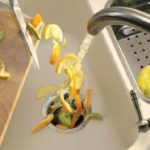Most citizens have only seen the disposer in American films. You can rarely meet such a device in the apartments of Russians. The food waste disposer is a pretty useful thing. No more cockroaches, crumbs and various cleanings! No unpleasant odors from the bucket and drain!
Here's how to choose a sink food waste disposer. We will also discuss the principle of operation of this device, its advantages and disadvantages.
Types of food waste disposers
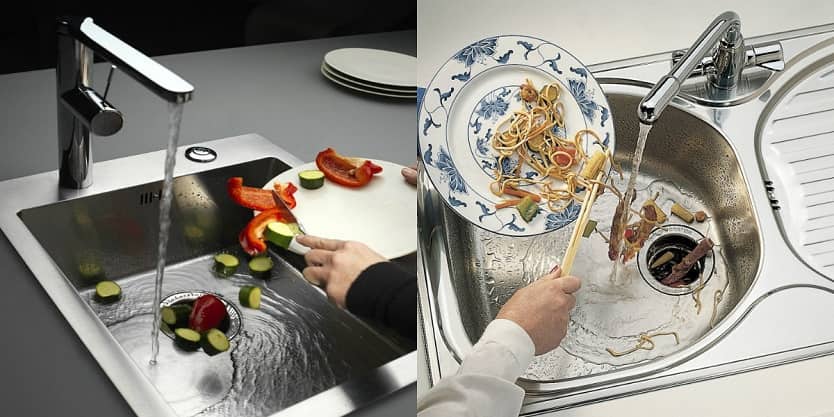
Today, on the market of household appliances for the kitchen, you can find 2 types of dispensers. Each has its own characteristics of work, advantages and disadvantages.
Hydraulic dispenser
Such models are very unpretentious and quite reliable. They are powered by a stream of water, hence the name. The principle of operation is simple: the user opens a tap and water flows through the grinder, activating it.
Among the positive qualities of the device, one can note its efficiency. It does not require the use of electrical energy to operate. Another of its good aspects is its almost silent operation. This, perhaps, is where the pros end.
The biggest disadvantage of hydraulic shredders is that you cannot turn it off at will. It will work whenever you turn on the tap. So it's worth keeping an eye on what you put in the sink. Otherwise, the disposer can crumble into porridge what you absolutely did not plan to “feed” him.
If you live on the top floor and your house has problems with the water supply, such a disposer will not work for you. It simply will not be able to work due to the weak pressure in the pipes. In addition, the hydraulic waste shredder is not very powerful. It can break if loaded with chicken bones or fruit bones.
Electric dispenser
Only a specialist should install such a device. After all, the electric dispenser has direct contact with water and electricity at the same time.
Electric models are quite powerful and can handle not only soft food waste, but even small bones from fish or chicken. The advantage of such disposers is that you can turn them on and off as you wish. They have nothing to do with the pressure of the water in the tap and will work when you want it.
There are also drawbacks to electric dispensers. First of all, it's a pretty noisy job. Not everyone will like the sound of the motor driving the device. The arrangement of such a shredder involves the output of a control button. Sometimes, to equip it, you have to drill an additional hole in a new countertop or "poke" a wall. And of course, such a shredder consumes additional electricity. You will not spend much, but it is still an additional expense.
Why do you need a recycler
It is impossible to cook dinner without leaving any waste behind.Most often, housewives use cellophane bags placed in a trash can for their disposal.
Those who are consciously concerned with the ecological component place special containers in their kitchens, and they approach the issue of waste disposal as responsibly as possible. Plastic, glass and paper are recycled, but food waste has to be taken to the trash heap.
In order to get rid of unpleasant-smelling food residues as quickly as possible, a kitchen utilizer was invented. Of course, you still have to go to the yard container. However, you will do this much less often.
The only drawback of such a device is that not all waste can be put into it. Sufficiently soft potato peelings are quite tough for him. But hard seeds from peaches or apricots should not be sent there.
How does a kitchen waste heat exchanger work?
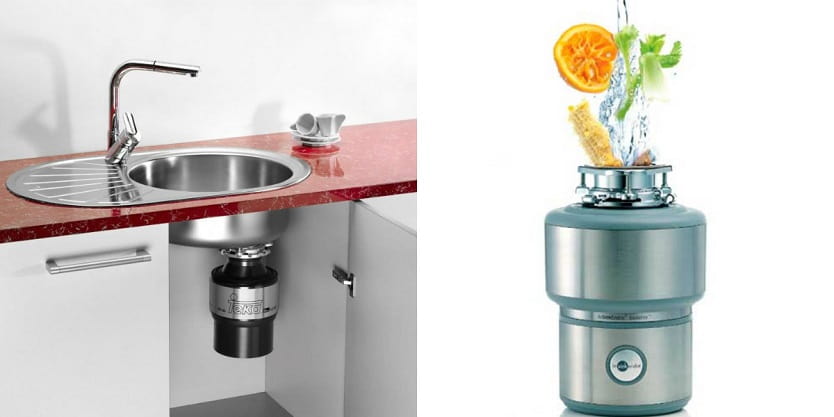
The principle of operation of a household disposer is quite simple. With the help of special devices, he grinds food particles that enter into a fine gruel. After that, the resulting mass is washed off with a stream of water into the central sewer.
The unit is placed under the kitchen sink. It must be installed in place of the siphon and equipped with a drain into the sewer. The design includes only two key elements:
- drive unit;
- grinding chamber.
Contrary to popular belief imposed on us by Hollywood films, the device does not have any monstrous knives. Inside the chamber there are freely "floating" hammers, which, when moving, rotate and rub against the ribbed walls of the tank surface. Thus, the waste is rubbed against the inner surface of the chamber and descended into the sewer pipe.
Main selection criteria
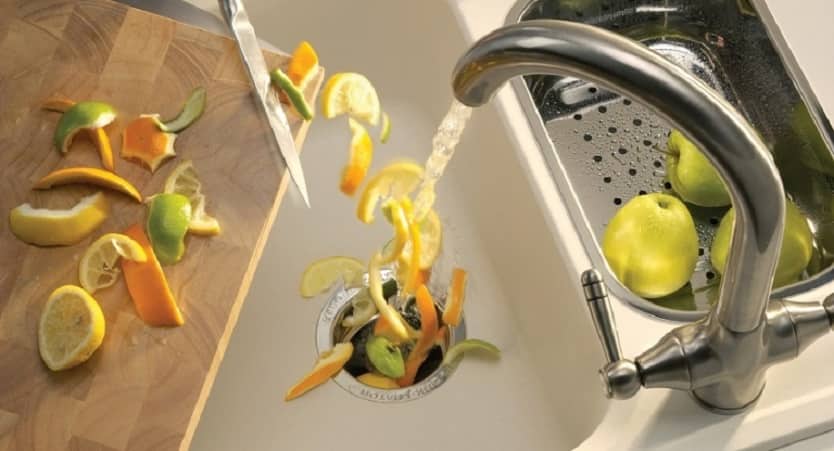
To get the most suitable food waste disposer, you need to know what to look for.
Power
This indicator is important for electrical models. After all, you want to spend as little as possible, but at the same time not lose in quality. For a young family of 2-3 people, a 550-600 W dispenser is enough. But this is in the event that you do not plan to load everything into it. Models capable of "gnawing" even large bones or nutshells consume at least 1300 watts from the network. And such an indicator cannot be called economical in any way.
Chamber volume
It all depends on the previous point. The more powerful your chopper motor, the larger the crushing chamber. Devices that are too small are definitely low-powered and not suitable for everyone. Of course, when choosing, you should pay attention to the fact that the device fits freely under the sink.
Rotation speed of hammers (knives)
In hydraulic models, this indicator directly depends on the water pressure in the tap. For electric ones, you should pay attention to an indicator of at least 1400 rpm. The faster the hammers turn, the more waste you can recycle.
Materials
The ideal option is stainless steel. This is not only a fairly strong material, it also does not corrode. An alternative can be a metal-plastic housing with an anti-corrosion coating inside.
To make the most correct choice, you should additionally pay attention to the presence of such options:
- the presence of additional noise insulation;
- the possibility of reversible rotation;
- ability to work in several speed modes;
- built-in overload protection;
- reinforced drain flange;
- safety guarantee in the form of a long tube for feeding waste to the shredder;
- the presence of additional conditions for placement regarding the sewer drain;
- the need to clean the device only with special branded products;
- maintainability and availability of service departments in your city.
How to use the disposer
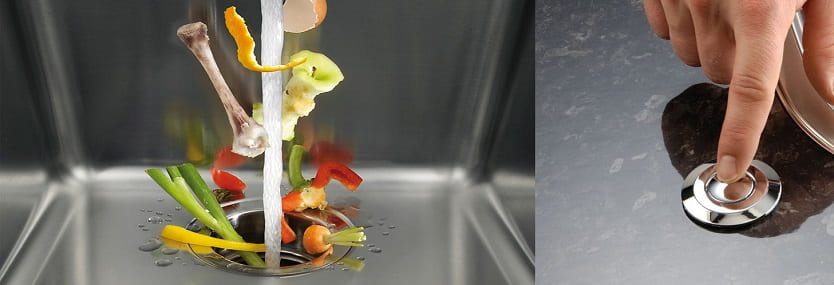
Anyone can use a properly connected sink shredder. This is absolutely nothing complicated.
- Open the tap and set a fairly strong water pressure.
- Turn on the chopper (hydraulic turns on automatically).
- Load cooked food waste into the sink drain.
- Wait 3-5 minutes. The end of the work is signaled by the absence of grinding noise.
- Turn off the device and drain the water for another 20-30 seconds.
- Close the tap.
Important:
It is extremely important to only run the dispenser with water. Otherwise, the device will not work or will quickly fail.
Shredder care
The food waste disposer is essentially self-cleaning. But all the same, he needs care.
- From time to time during the operation of the device, turn on not cold water, but warm one. This will help get rid of the greasy deposits that accumulate on the walls of the appliance.
- Never turn off the tap immediately after turning off the disposer. Let the water flow for a few more seconds. This will maximize the removal of the smallest particles of ground food into the sewer.
- Add lemon zest and cubes of frozen soda solution to the grinder regularly. This will help avoid unpleasant odors from the drain.
- When installing the device, try not to use a corrugated pipe. Particles of waste can get stuck in its folds, which can subsequently lead to a blockage.
- Once or twice a year, fill the sink with a special cleaning agent specially designed for waste disposal units. It will help clean the unit from plaque, unpleasant odors and microbes.
TOP - 3 popular models
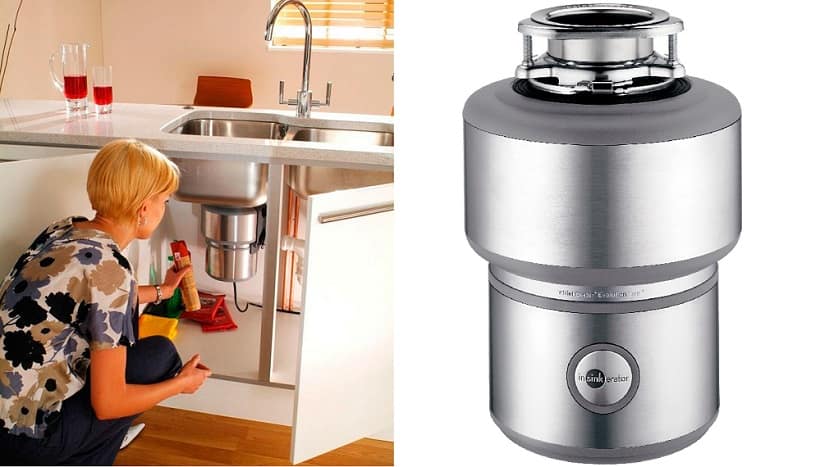
In conclusion of our article, we present to your attention a small rating of food waste disposers that have gained the most popularity according to user reviews.
InSinkErator Evolution 200
Incredibly powerful and roomy dispenser. Engine power of about 0.6 kW and a working chamber of 1.2 liters, allow you to process a fairly large amount of waste. The design includes the Jam-Sensor Circuit system, which allows, if necessary, to increase the motor rotation by 500%. All parts of the structure are made of stainless steel, there is a built-in overload protection. Despite the fact that the model is electric, the engine noise is practically inaudible. The only drawback of this model may be the rather high cost. But if you believe the reviews, everything pays off quickly enough.
Zorg ZR-75 D
Another fairly popular shredder for kitchen waste. With an engine power of 0.75 kW, it has a 1.2 liter processing chamber. The rotation speed of the working disk is 2600 rpm, which allows you to cope with small bones and eggshells. The Zorg ZR-75 D has a specially designed noise reduction system and an automatic reversing system. Compared to the previous model, it is very affordable.
STATUS Premium 300
Our small grinder rating is completed by another pretty good model. The system is equipped with a special anti-vibration ring. This minimizes the stress on stone and porcelain stoneware sinks. Has a three-level grinding system and a continuous feeding system. According to users' reviews, STATUS Premium 300 is not too noisy and does an excellent job with the task.
We really hope that our article will help you choose the right food waste disposer for your sink. Already after a short time, the disposer will become simply irreplaceable for you.

